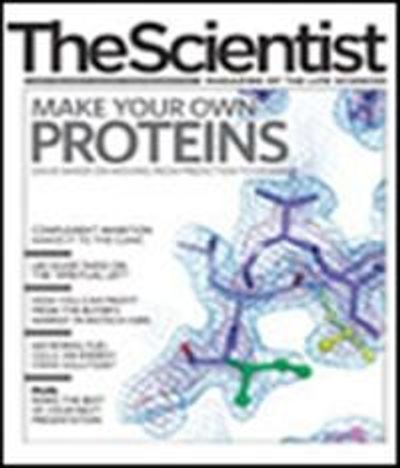
Signaling pathways, for all their elegance, serve but one purpose: to convert extracellular signals into intracellular changes. Whether it's insulin or isoleucine, antigen or adrenaline, the end result is most always the same: changes in transcriptional activity.
Such effects are caused by changes in transcription factor-binding patterns at gene regulatory regions like promoters, enhancers, and silencers. Classically, the electrophoretic mobility shift assay (gel shift), has been the assay of choice for demonstrating that a particular protein can bind to a specific short sequence. Yet gel shifts are slow, low-throughput, nonquantitative, and radioactive. And when they're done, you still don't know what proteins, or groups of proteins, are ultimately responsible for directing transcriptional changes in vivo, or even that the sequence in vivo is actually accessible and able to bind potential regulators.
To do that, to determine precisely what protein is binding to a site,...
References
1. H. Qiao et al., "Fc∈R1 and Toll-like receptors mediate synergistic signals to markedly augment production of inflammatory cytokines in murine mast cells," Blood, 107:610-8, Jan. 15, 2006. 2. F. Zandbergen et al., "The G0/G1 switch gene 2 is a novel PPAR target gene," Biochem J, 392(Pt. 2):313-24, 2005.PROTEIN ARRAYS
What they are: Arrays of immobilized transcription factors, probed using either labeled sequences or proteins.
What to use them for: Identifying factor-binding sites or protein-protein interactions in discovery mode.
Pros: Provide a rapid way to test a given sequence against a range of factors.
Cons: Will miss interactions dependent on heterodimerization and posttranslational changes.
Things to keep in mind: Protein arrays provide a way to screen DNA fragments for potential binding sites. But the format is relatively inflexible: Only widely studied factors are present on the arrays, and making your own array is not trivial.
Available kits: Examples include Panomics' TF Protein Array I for DNA-Protein Interactions (48 proteins, Catalog No. MA3505, $863), and Active Motif's TransArray (38 proteins, two membranes, Catalog No. 31400, $580).
MICROSPHERE ASSAYS
What they are: Collections of addressable (i.e., individually colored) microbeads, each coupled to a unique factor-binding site.
What to use them for: Screening transcription-factor expression in discovery mode.
Pros: Provide a relatively broad, unbiased first-pass screen; in theory, up to 100 different factors can be tested at once.
Cons: Requires specialized hardware (e.g., a Luminex reader); doesn't reveal exactly which protein is binding to and protecting the sequence.
Things to keep in mind: Like RNAse protection assays, bead-based systems quantify the ability of transcription factors to protect an oligonucleotide from nuclease digestion. Anna Lokshin, who heads the Luminex core facility at the University of Pittsburgh Medical Center, says the bead approach can lead to unexpected findings because it is unbiased by hypotheses and preliminary data. "Normally you search on your own knowledge," she says, "but your own knowledge is limited."
Available kits: Examples include Invitrogen's BioSource 3-plex Transcription Factor Assays (100 tests, Catalog No. LHF2041, $845), and Marligen Biosciences' Multiplex Transcription Factor Profiling Kit (20-plex) (96 reactions, Catalog No. 11954-096, Price $2,899).
CHROMATIN IMMUNOPRECIPITATION
What it is: Immunoprecipitation of cross-linked protein-DNA complexes from native chromatin, detected either via PCR or microarrays.
What to use it for: Identifying protein-DNA binding events in their natural, intracellular context.
Pros: The only assay that works in vivo, it can also detail how protein occupancy changes over time.
Cons: Requires an antibody to your transcription factor. Also, ChIP is "much more complicated and difficult" than gel shifts," says Sara Sukumar of Johns Hopkins University.
Things to keep in mind: ChIP says nothing about whether a particular binding event is functional, says Sander Kersten, assistant professor of molecular nutrition at Wageningen University, the Netherlands, who published a paper last year about using gel shifts and ChIP2; for that, you need to use transcriptional activation assays. ChIP "is great," he says, "but you still need to finish the whole picture with other techniques."
Available kits: Examples include Active Motif's ChIP-IT (25 reactions, Catalog No. 53001, $395), and Upstate's EZ ChIP (22 reactions, Catalog No. 17-371, Price $329).
OLIGONUCLEOTIDE ARRAYS
What they are: Arrays of immobilized binding-site oligonucleotides, typically probed with nuclear extracts and developed with antibodies against specific proteins.
What to use them for: Screening transcription-factor expression in discovery mode.
Pros: Provide a relatively broad, unbiased first-pass screen.
Cons: More qualitative than quantitative; requires antibodies against each transcription factor.
Things to keep in mind: Michael Beaven, deputy chief of the laboratory of molecular immunology at the National Heart, Lung, and Blood Institute, "found there was some variability from experiment to experiment" when he used a Panomics array recently to study mast cell responses to activation via the IgE and Toll-like receptor pathways.1 "We initially started with the Panomics arrays to get some idea as to what was going on," Beaven says, "which it did reasonably well."
Available kits: Panomics' Protein/DNA Combo Array (345 sites, Catalog No. MA1215, $1,415), and ArrayIt Transcription Factor Microarrays (expected Fall 2006, estimated price $600-$900).
ELISA-BASED ASSAYS
What they are: Transcription-factor binding assays based on the enzyme-linked immunosorbency assay (ELISA).
What to use them for: Quantification of transcription-factor concentration.
Pros: Fast, quantitative, and amenable to high-throughput work.
Cons: Require an antibody to your transcription factor.
Things to keep in mind: Vladamir Todorov, assistant professor at Regensburg University in Germany, says ELISA-based assays can accommodate more protein than a typical gel shift. "If your signal is pretty low, you can enhance it in this way," he says. Tatiana Syrovets, of the University of Ulm, Germany, says ELISA-based kits are also more quantitative. But they don't provide absolute protein levels, she notes: "It's semiquantitative, I would say."
Available kits: Examples include Clontech's TransFactor STAT3 Colorimetric Kit (1 x 96 assays, Catalog No. 631953, $583), Panomics' HIF ELISA Kit (1 x 96 assays, Catalog No. EK1020, $518), and Active Motif's TransAM CREB Kit (1 x 96 assays, Catalog No. 42096, $585).
Interested in reading more?




